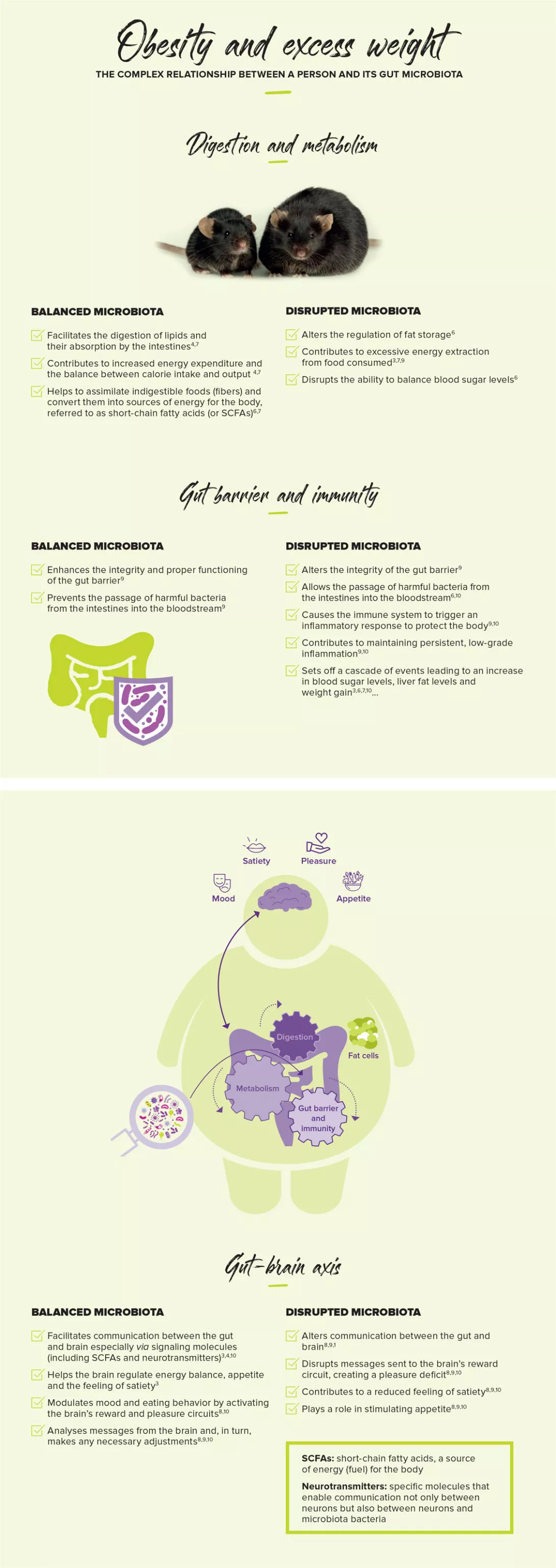Is there a link between gut microbiota and weight?
The 100 trillion microorganisms (bacteria, viruses and fungi) that live in the gastrointestinal tract are actively involved in our body’s ability to properly absorb nutrients. However, eating a diet high in sugar and fat results in a disturbed energy balance. Disrupted in turn (less rich and diverse), the gut microbial ecosystem is no longer able to regulate the excess energy absorbed and itself contributes to maintaining this imbalance.
- Learn all about microbiota
- Microbiota and related conditions
- Act on your microbiota
- Publications
- About the Institute
Healthcare professionals section
Find here your dedicated section
Sources
This article is based on scientific information
Sections

About this article
The gastrointestinal tract is populated by bacteria, viruses and fungi. Among them, the two dominant bacterial phyla (Bacteroidetes and Firmicutes, including
(sidenote:
Lactobacilli
Rod-shaped bacteria whose main characteristic is the production of lactic acid, from where they get the name “lactic acid bacteria”.
Lactobacilli are present in the oral, vaginal and gut microbiota of humans, but also in plants and animals. They are found in fermented foods, such as dairy products (e.g. certain cheeses and yoghurts), pickles, sauerkraut, etc.
Lactobacilli are also found in probiotics, with certain species recognized for their beneficial properties.
W. H. Holzapfel et B. J. Wood, The Genera of Lactic Acid Bacteria, 2, Springer-Verlag, 1st ed. 1995 (2012), 411 p. « The genus Lactobacillus par W. P. Hammes, R. F. Vogel
Tannock GW. A special fondness for lactobacilli. Appl Environ Microbiol. 2004 Jun;70(6):3189-94.
Smith TJ, Rigassio-Radler D, Denmark R, et al. Effect of Lactobacillus rhamnosus LGG® and Bifidobacterium animalis ssp. lactis BB-12® on health-related quality of life in college students affected by upper respiratory infections. Br J Nutr. 2013 Jun;109(11):1999-2007.
)
) represent nearly 90% of the gut microbiota3. The remaining 10% consists of Proteobacteria (including Escherichia coli, known to be sometimes harmful) and Actinobacteria, including beneficial
(sidenote:
Bifidobacterium
A genus of Y-shaped bacteria, most species of which are beneficial to humans. They are found in the gut of humans, and in some yogurts.
They:
- Protect the gut barrier
- Participate in the development of the immune system and help fight inflammation
- Promote digestion and improve symptoms of gastrointestinal disorders
Sung V, D'Amico F, Cabana MD, et al. Lactobacillus reuteri to Treat Infant Colic: A Meta-analysis. Pediatrics. 2018 Jan;141(1):e20171811.
O'Callaghan A, van Sinderen D. Bifidobacteria and Their Role as Members of the Human Gut Microbiota. Front Microbiol. 2016 Jun 15;7:925.
Ruiz L, Delgado S, Ruas-Madiedo P, et al. Bifidobacteria and Their Molecular Communication with the Immune System. Front Microbiol. 2017 Dec 4;8:2345.
)
3. A well-balanced gut microbiota contributes to good health and a number of processes. It aids digestion and proper intestinal cell function, interacts with the immune system, prevents invading molecules and bacteria from crossing the gut epithelium and also communicates with the brain. In obese and overweight individuals, the gut microbiota seems to be unbalanced (
(sidenote:
Dysbiosis
Generally defined as an alteration in the composition and function of the microbiota caused by a combination of environmental and individual-specific factors.
Levy M, Kolodziejczyk AA, Thaiss CA, et al. Dysbiosis and the immune system. Nat Rev Immunol. 2017;17(4):219-232.
)
). This means it is generally less abundant and diverse9 with a reduction of beneficial bacterial species such as Akkermansia muciniphila and
(sidenote:
Bifidobacterium
A genus of Y-shaped bacteria, most species of which are beneficial to humans. They are found in the gut of humans, and in some yogurts.
They:
- Protect the gut barrier
- Participate in the development of the immune system and help fight inflammation
- Promote digestion and improve symptoms of gastrointestinal disorders
Sung V, D'Amico F, Cabana MD, et al. Lactobacillus reuteri to Treat Infant Colic: A Meta-analysis. Pediatrics. 2018 Jan;141(1):e20171811.
O'Callaghan A, van Sinderen D. Bifidobacteria and Their Role as Members of the Human Gut Microbiota. Front Microbiol. 2016 Jun 15;7:925.
Ruiz L, Delgado S, Ruas-Madiedo P, et al. Bifidobacteria and Their Molecular Communication with the Immune System. Front Microbiol. 2017 Dec 4;8:2345.
)
and an increase in potentially harmful bacteria that contribute to weight gain through yet-tobe- understood mechanisms.9.
The vicious cycle of dysbiosis
Be it the cause or the consequence, gut microbiota plays a role in obesity. When altered, there are many health implications including digestive disorders, impaired defense mechanisms and its reduced capacity to communicate with the brain to control hunger8. These disturbances in turn maintain gut microbiota dysbiosis9. More than just a metabolic disorder, obesity would therefore be associated with brain and immune system dysfunction which manifests itself in abnormal eating behaviors in which gut microbiota plays a role3,4,8,10.
Let us explain!








